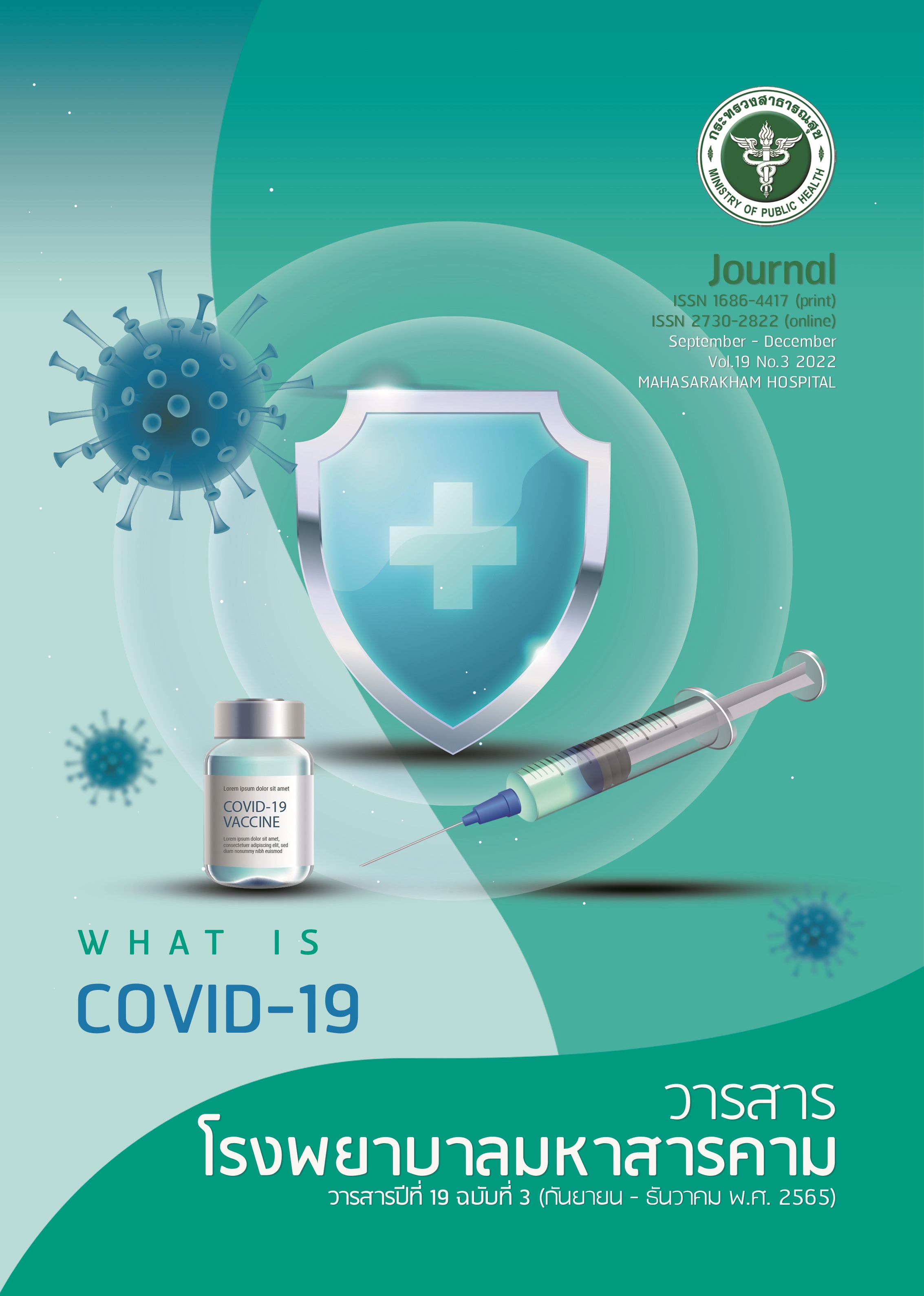Factors Associated with Severe Pneumonia among Coronavirus Disease 2019
Keywords:
Factors associated, Severe Pneumonia, Coronavirus disease 2019Abstract
Objective : To study factors associated with severe pneumonia among coronavirus disease 2019 patients in a cohort ward, Mahasarakham Hospital
Method : This research is a retrospective analytic study. The sample was confirmed cases of coronavirus disease 2019 who were admitted to a cohort ward at Mahasarakham Hospital between 1 January and 30 June 2022. The sample of 198 cases was selected by purposive sampling based on the inclusion criteria. Data were collected from medical records using a record form and were analyzed by descriptive and inferential statistics applying logistic regression analysis. Adjusted odds ratio (OR adj) and 95% confidence interval were presented.
Results : Most of the patients are female (57.10%), The mean age is 58.80 ± 20.38 years. It was revealed that co-morbid diabetes (OR adj = 3.24, 95% CI 1.28-8.21), hypertension (OR adj = 2.92, 95% CI 1.30-6.57), chronic kidney disease (OR adj = 6.50, 95% CI 2.79-15.11), initial oxygen saturation levels below 96% (OR adj = 2.73, 95% CI 1.05-7.14), and unvaccinated (OR adj= 10.11, 95% CI 4.12-24.81) are factors statistically significantly associated with pneumonia among coronavirus disease 2019 patients (p < .05).
Conclusion : Patients with comorbidity, especially diabetes, hypertension, and chronic kidney disease, as well as those whose initial oxygen saturation level is lower than 96% and who are not vaccinated, are likely to get risk of severe pneumonia. They should be closely supervised and monitored.
References
Rajnik M, Cascella M, Cuomo A, Dulebohn SC, Di Napoli R. Features, evaluation, and treatment of coronavirus (COVID-19). Uniformed Services University Of The Health Sciences; 2021.
Whitaker M, Elliott J, Bodinier B, Barclay W, Ward H, Cooke G, et al. Variant-specific symptoms of COVID-19 in a study of 1,542,510 adults in England. Nature Communications. 2022;13(1):1-10.
Grant MC, Geoghegan L, Arbyn M, Mohammed Z, McGuinness L, Clarke EL, et al. The prevalence of symptoms in 24,410 adults infected by the novel coronavirus (SARS-CoV-2; COVID-19): A systematic review and meta-analysis of 148 studies from 9 countries. %J PloS one. 2020;15(6):e0234765.
Pongpirul WA, Wiboonchutikul S, Charoenpong L, Panitantum N, Vachiraphan A, Uttayamakul S, et al. Clinical course and potential predictive factors for pneumonia of adult patients with Coronavirus Disease 2019 (COVID-19): A retrospective observational analysis of 193 confirmed cases in Thailand. PLoS neglected tropical diseases. 2020;14(10):e0008806.
Nuevo-Ortega P, Reina-Artacho C, Dominguez-Moreno F, Becerra-Muñoz VM, Ruiz-Del-Fresno L, Estecha-Foncea MA. Prognosis of COVID-19 pneumonia can be early predicted combining Age-adjusted Charlson Comorbidity Index, CRB score and baseline oxygen saturation. Scientific reports. 2022;12(1):1-12.
Oliver-Commey JA, Puplampu P, Owoo C, Asare-Boateng K, Yawson AO, Tetteh J, et al. Prevalence of pneumonia by chest x-ray, associated demographic characteristics and health risk factors among COVID-19 patients in Ghana. Ghana medical journal. 2021;55(2):21-8.
Aziz M, Fatima R, Assaly R. Elevated interleukin‐6 and severe COVID‐19: a meta‐analysis. Journal of medical virology. 2020;92(11):2283-5.
Tzotzos SJ, Fischer B, Fischer H, Zeitlinger M. Incidence of ARDS and outcomes in hospitalized patients with COVID-19: a global literature survey. Critical Care. 2020;24(1):1-4.
Brogna B, Bignardi E, Brogna C, Capasso C, Gagliardi G, Martino A, et al. COVID-19 Pneumonia in Vaccinated Population: A Six Clinical and Radiological Case Series. Medicina. 2021;57(9):891.
Schiebler M, Bluemke D. Seeing Is Believing: COVID-19 Vaccination Leads to Less Pneumonia at Chest CT. Radiology. 2022;303(3):693-5.
Bajpai J, Kant S, Verma A, Patwa AK, Atam V, Chaudhary SC, et al. The Severity of COVID 19 Pneumonia in Vaccinated vs. Non-vaccinated Patients in the Second Wave: An Experience From a Tertiary Care Center in India. Cureus. 2022;14(5):1-12.
Murillo-Zamora E, Trujillo X, Huerta M, Ríos-Silva M, Guzmán-Esquivel J, Benites-Godínez V, et al. COVID-19 vaccines provide better protection against related pneumonia than previous symptomatic infection. International Journal of Infectious Diseases. 2022;120:142-5.
Saritsiri S, Mongkolchati A, Suksaroj T. Prevalence of chronic kidney disease and related factors among diabetic patients in primary care, Bangkok, Thailand. Journal of Public Health and Development. 2021;19(1):1-18.
Ingsathit A, Thakkinstian A, Chaiprasert A, Sangthawan P, Gojaseni P, Kiattisunthorn K, et al. Prevalence and risk factors of chronic kidney disease in the Thai adult population: Thai SEEK study. Nephrology Dialysis Transplantation. 2010;25(5):1567-75.
Duan J, Wang C, Liu D, Qiao Y, Pan S, Jiang D, et al. Prevalence and risk factors of chronic kidney disease and diabetic kidney disease in Chinese rural residents: A cross-sectional survey. Journal Scientific Reports. 2019;9(1):1-11.
Syed-Ahmed M, Narayanan M. Immune dysfunction and risk of infection in chronic kidney disease. Advances in chronic kidney disease. 2019;26(1):8-15.
หอผู้ป่วยเฉพาะโรค โรงพยาบาลมหาสารคาม. รายงานสรุปตัวชี้วัด เกณฑ์ และผลลัพธ์การดูแลผู้ป่วย หอผู้ป่วยเฉพาะโรค โรงพยาบาลมหาสารคาม ประจำปี 2564. มหาสารคาม, โรงพยาบาลมหาสารคาม; 2564.
Polit DF, Beck CT, Owen SV. Is the CVI an acceptable indicator of content validity? Appraisal and recommendations. Research in Nursing Health. 2007;30(4):459-67.
Risitano AM, Mastellos DC, Huber-Lang M, Yancopoulou D, Garlanda C, Ciceri F, et al. Complement as a target in COVID-19? Nature Reviews Immunology. 2020;20(6):343-4.
Alipoor SD, Jamaati H, Tabarsi P, Mortaz E. Immunopathogenesis of Pneumonia in COVID-19. Tanaffos. 2020;19(2):79-82.
Downloads
Published
How to Cite
Issue
Section
License
Copyright (c) 2022 Mahasarakham Hospital Journal

This work is licensed under a Creative Commons Attribution-NonCommercial-NoDerivatives 4.0 International License.
วารสารนี้เป็นลิขสิทธิ์ของโรงพยาบาลมหาสารคาม





